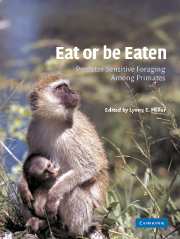Preface
Published online by Cambridge University Press: 10 November 2009
Summary
The story of this volume is probably a common one. The book was born out of my frustration over an apparent impasse in primatology and my excitement at discovering that other ecologists had, in fact, moved beyond that obstacle. From my first year in graduate school, I was frustrated by what I perceived as a false dichotomy, the seemingly endless debate among primate socioecologists over the adaptive functions of grouping: Did primates live in groups to reduce predator pressure or to increase foraging success? Surely, I always thought, both factors could be important. Then I got out to the field and was fascinated by the variability in behavior that I was observing among capuchin monkeys. Some monkeys took risks that others avoided, and these different strategies led to differential access to food and water. Clearly, the monkeys were behaving in ways that balanced their simultaneous desires for safety and full stomachs, and the particular balance that each individual struck was based (it seemed to me) upon how vulnerable that individual was (or perceived itself to be). Upon delving into the ecological literature, I found a vast body of data pertaining to this exact balancing act: predator sensitive foraging. Countless scientists working with diverse taxa – insects, fish, birds, rodents, ungulates – were already investigating the strategies that animals use to enhance foraging success under the constraints of predator pressure. But where was the research on primates? There were some important studies, but they were remarkably few.
My enthusiasm for exploring predator sensitive foraging among primates led me to propose a symposium on the subject.
- Type
- Chapter
- Information
- Eat or be EatenPredator Sensitive Foraging Among Primates, pp. x - xiiPublisher: Cambridge University PressPrint publication year: 2002

